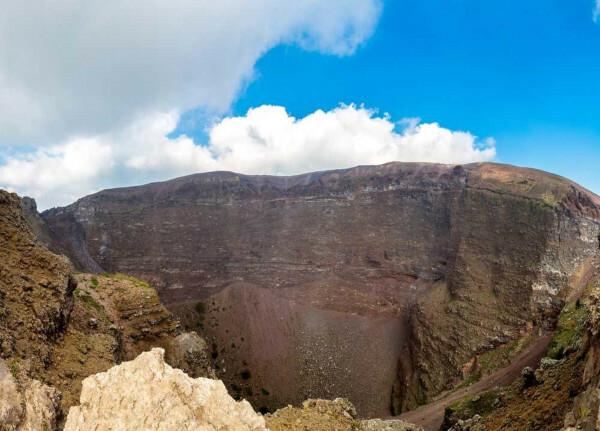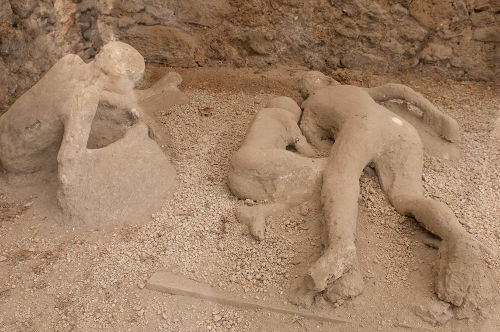Pompeii it was a city roman which was noted for having been stage of a large volcanic eruption, which took place on Mount Vesuvius and was responsible for the city's destruction as well as the decimation of its population. The city's archaeological remains were found in the 18th century and, since then, studies have been carried out to reconstruct the facts of the city's daily life and its destruction.
Read too: Great Fire of Rome—One of the Greatest Catastrophes of Antiquity
Origins of Pompeii
The city of Pompeii was located at the foot of Mount Vesuvius, near the current city of naples, in a region of Italy known as Campania. Historians point out that the region of Pompeii began to be inhabited around the Bronze Age (between 3,000 and 1,200 BC. Ç.). The original name and who started the occupation of that location are not yet known.

In any case, historians know that, before the Romans, the city of Pompeii was occupied by the Oscos (a people who inhabited Campania),
greeks, Etruscans and Samnites, before finally being conquered by the Romans. THE Roman influence on Pompeii came after the Samnite Wars (IV century a. C.), conflicts waged by the Romans against the Samnitas who yielded to them a series of territories in the Italian Peninsula.After the Samnite Wars, the city of Pompeii came under Roman influence, but had some autonomy. This autonomy ended in 80 a. C., when sithere ordered the siege of the city in retaliation for Pompeii's participation in a rebellion against Roman authority. As a result, approximately five thousand soldiers were installed in the city. With the Roman conquest, the period of greatest prosperity in Pompeii began.
Do not stop now... There's more after the advertising ;)
The city of Pompeii before the destruction
Before the eruption that destroyed and buried Pompeii, the city he was at the height of his prosperity. It was on the shores of the Mediterranean Sea, so it was used by the Romans to transport various goods. During the 1st century d. C., Pompeii owned approximately 12 thousand inhabitants in urban areas and 24,000 inhabitants in the countryside.

From the coast of Pompeii, goods produced in neighboring towns and items such as olives, olive oil, cabbage, figs, salt and nuts were exported. Among the imported goods were silk, slaves, spices, etc. despite your commercial importance, Pompeii is seen as a provincial city.
Pompeii had walls at its ends and its interior was formed by several buildings, such as shops, temples, taverns (place where drinks were sold alcoholic), public restrooms, arenas - where gladiator fights took place -, toilets, simple residences and Luxurious, etc.
In Pompeii, they worshipedif the traditional gods of Roman religion, as pointed out by the archaeological discoveries that took place from the 18th century onwards. There were several temples to the Roman gods in the city, as well as small shrines in the residences. Archaeologists have also discovered frescoes in the city that portray issues relating to religion, such as a fresco in the village. of the Mysteries which, according to historians, is a probable Dionysian cult (known as Bacchus by the Romans).
Pompeii and the coastal region of Campania often received part ofroman aristocracy in summer houses near the sea. There are records that even the emperor Nero (reigned between 54 and 68 d. C.) has visited the city during a gladiator competition in 66 d. Ç.
Unlike the popular image that was built about the Romans and, mainly, about the inhabitants of Pompeii, the city was not marked by debauchery and immorality. The Roman religion, as the inhabitants believed, brought a well-moralized perspective on life and, therefore, this idea of Pompeii as a place of debauchery is not accepted by historians.
Also access: Roman Empire — the stage in which Roman civilization reached its peak
What happened to the city of Pompeii?
THE destruction of the city of Pompeii happened in 79 d. Ç. The story of Pliny the Younger points to the 24th of August, 79 d. C., but some historians suggest that the destruction of the city took place at the end of September. This city was destroyed in a volcanic eruption of large proportions, which buried the city in volcanic material and decimated the entire population that had not fled the area. Before the volcanic eruption, Pompeii had suffered a partial destruction in 62 d. C., on account of an earthquake.
Pompeii was hit by a stone rain (many gigantic) expelled from within Mount Vesuvius. Also, the next day, the city was hit by toxic gases, who killed the inhabitants who had survived the previous day's rockfall. An account of the volcanic eruption comes 25 years after the one by a Roman named Pliny the Younger.
The eruption of Vesuvius not only hit Pompeii, but was also responsible for the destruction of other cities.
The rediscovery of Pompeii

The city of Pompeii was practically forgotten during the following centuries. His rediscovery happened in XVIII century, when excavations ordered by Spanish King Charles III (at the time southern Italy was dominated by the Spaniards) uncovered the archaeological remains of what had once been Pompeii.
The identification of the city was only possible thanks to the inscriptions found, which named the city Pompeii. The city was found beneath dozens of layers of volcanic material, which accumulated after the eruption and over time. Because it was buried, historians managed to find very well preserved artifacts, which were very important in the reconstruction of the city's daily life.
In 1997, the city was transformed into Historical Heritage of Humanity for the UNESCO and currently it is an important place of visitation, receiving about 2.5 million tourists annually. There are, however, allegations that the entire collection in Pompeii is not receiving the necessary attention and, therefore, the facilities are deteriorating year after year.
Geography of Mount Vesuvius

volcanoes they are geological structures generally with a mountainous and conical shape that constitute an opening in the earth's crust capable of releasing magmatic material, gases and ash to the surface. In southern Italy, in the Bay of Naples, there is a famous volcano: the so-called Mount Vesuvius.
O Vesuvius is a currently dormant volcano, but that has shown intense activity throughout history. More correctly called Somma-Vesuvius (because it grows inside what is left of the Mount Somma volcano), it is a well-known volcano for its frequent eruptions. Because it is located in an inhabited region, its activity could be observed over many years and some eruptions had catastrophic consequences.
Read too: Yellowstone — the biggest supervolcano on the planet
→ Geological features of Mount Vesuvius

Vesuvius is a 1,281 meter high stratovolcano and approximately 400,000 years, according to the dating of magmatic material samples. A volcano can have four different types of eruptions.
Strombolian eruption: usually explosive eruption ejecting ash accompanied by “volcanic bombs”. It also produces lava.
Hawaiian-type strombolian eruption: is not so destructive or violent. It does not eject gases and there is the presence of basaltic magma and, consequently, lava flow.
Eruption Plinian: presents violent explosions, caused by magma and gaseous content. The magmatic material is ejected violently into the air and creates a long eruptive plume. The tefra (unconsolidated volcanic material) is spilled nearby. In this type of eruption, high velocity lava flow can also occur. was this eruption type what caused the burial of the city of Pompeii. The name “Plinian” was given when some scholars proved that a Roman named Pliny had described correctly and in rich detail the catastrophic eruption that buried the cities of Pompeii and Herculaneum.
Subplinian eruptions: they resemble plinian eruptions but are less intense and therefore less destructive.
→ the eruption Plinian what buried Pompeii
The region encompassed by the city of Pompeii presented a lot of seismic activities. One of them preceded the tragedy that would devastate the city: a earthquake it shook the region 17 years earlier and destroyed the entire Gulf of Naples area.
You inhabitants of area were unaware that Mount Vesuvius was a volcano, therefore they did not imagine the imminent danger. The eruption with about 4 km³ of ash and rocks buried the city, and approximately 2000 inhabitants succumbed under several pyroclastic layers (set of hot gas, volcanic material, ash and debris of rocks). Ash spread across Pompeii, petrifying it and conserving the bodies.
→ Can Vesuvius get active again?
Records date Vesuvius' volcanic activity between 1631 and 1944. The last eruption occurred in the year 1944 and, since then, the volcano has been dormant. Not having many years since your last activity, can't consider it extinct. This means that he can, yes, get back to activity. For this reason, the city of Pompeii is monitored, and the government encourages the inhabitants who currently live in the area to move, in order to avoid another tragedy.
Read too: Lisbon Earthquake of 1755 — the tragedy that caused the city to be rebuilt
The chemistry involved in the destruction of Pompeii
→ Chemical composition of the Vesuvius volcano magma
O magma from the volcano Vesuvius is considered acidic, because it has a large concentration of acid oxides, such as carbon dioxide it's the sulfur dioxide, in addition to a high amount — about 70% — of silicon dioxide (SiO2).
The presence of silica and the mentioned gases make the magma of this volcano present a very high viscosity, which does not allow it to flow with great speed. Other oxides, but of origin basic, also make up magma, such as calcium oxide (CaO), potassium oxide (K2O), sodium oxide (N2O), among others.
→ Chemical composition of smoke expelled by the volcano Vesuvius

The smoke spewed by the volcano Vesuvius during and after the eruption killed several inhabitants of Pompeii because it was composed of three toxic gases:
carbon dioxide (acronym CO2);
hydrogen sulphide (H2S);
sulfur dioxide (SO2).
These gases have a density greater than the oxygen and nitrogen, soon remain in environments closer to the ground (where people were). Also, because they are invisible, people inhale them without knowing it. See the effects on the body of each of these gases.
sulfur dioxide: when inhaled, causes irritation and corrosion of the respiratory system.
Carbon dioxide: promotes asphyxia, as it competes with oxygen gas for the hemoglobin of red blood cells.
hydrogen sulfide: when inhaled, it prevents cell respiration in the mitochondria, that is, it prevents the cells from producing energy.
→ Petrification of some inhabitants of Pompeii

As the Vesuvius magma is very viscous, over time it solidifies inside the volcano itself. Therefore, on the day of the eruption that destroyed Pompeii, there were great explosions, which favored the fall of a large cloud of debris and ash on many residents.
Residents who were not disintegrated by the heat from the volcano died from the toxic gases, in addition to being covered by a cloud of silica and calcium oxide (Dog).
Silica and calcium oxide, when interacting with the water vapor in the air in the middle of heat, formed a kind of cement (very rigid in character), which enveloped people's bodies. This cement preserved the bodies of many of Pompeii's inhabitants, marking the moment they died.
By Daniel Neves
History teacher
Rafaela Sousa
Geography teacher and
Diogo Lopes
Chemistry teacher

